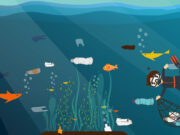Seals use their whiskers to sense food by tracking the vortices left by potential prey, for example by fish swimming.
The authors of a soon-to-be-published paper have used observations of seals to build a 3-D printed sensor that can be used on underwater robots for better positional control, navigation and object detection. An example of soft robotics.
The new materials-based whisker sensor is made of polyurethane, graphene and copper tape and can detect an underwater vortex with very high sensitivity.
Soft Robotics is the specific subfield of robotics dealing with constructing robots from highly compliant materials, similar to those found in living organisms.
Bio-mimicking the underwater sensors has tremendous potential in soft robotics and underwater exploration.
The new whisker sensor detects changes in resistance in the opposite direction to each other.
Further Reading
Gul Jahan Zeb, Su Kim Young, and Choi Kyung Hyun. Soft Robotics. January 2018, ahead of print. https://doi.org/10.1089/soro.2016.0069

















